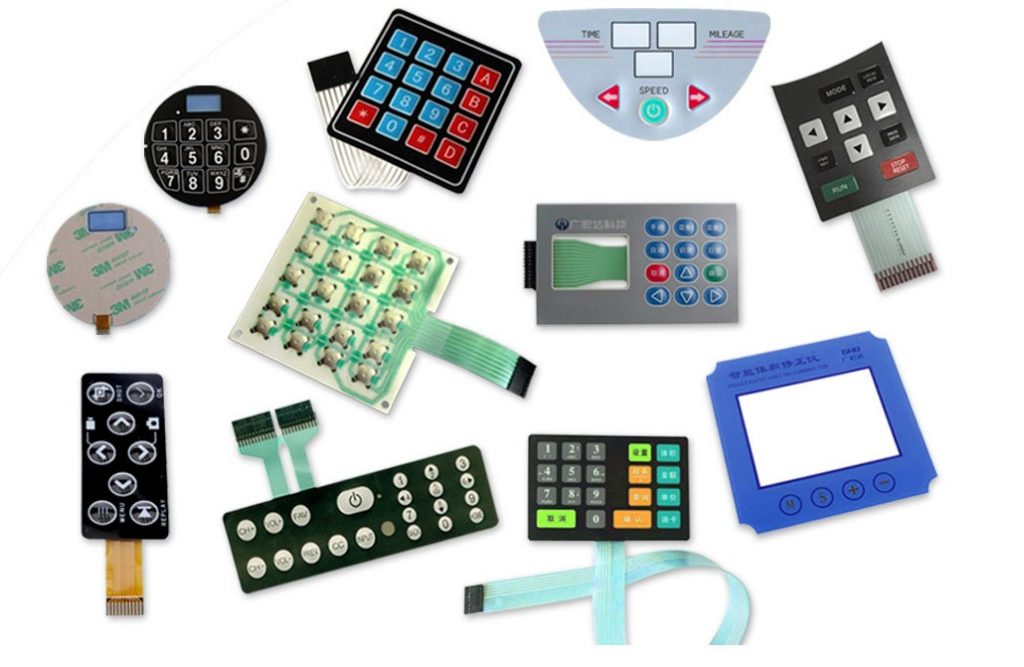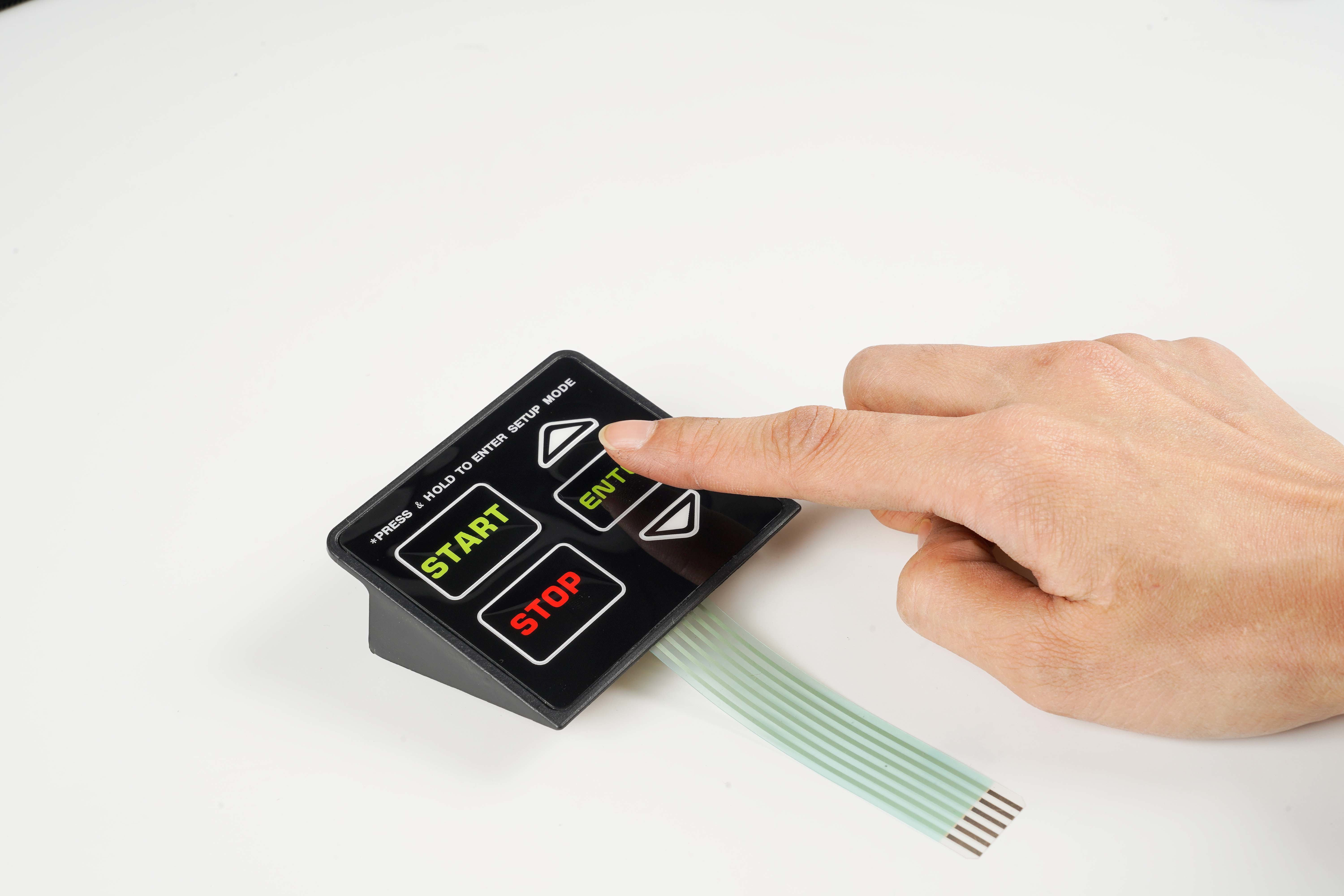Everything About Membrane Switch Over: A Comprehensive Overview for Beginners
Membrane buttons are vital components in modern-day electronics, offering a special interface for customer interaction - membrane switch. Their layered building and construction, including overlays and conductive traces, provides performance and toughness. Unlike conventional mechanical buttons, membrane buttons present a streamlined design and personalized choices. Recognizing their essential attributes and benefits can change product style. The intricacies of their application and style factors to consider warrant additional exploration.
What Is a Membrane layer Switch?
A membrane button is a kind of electrical switch that is composed of a flexible membrane layered over a published motherboard. This design enables a streamlined and portable interface, commonly made use of in various electronic gadgets. Membrane layer buttons are commonly found in consumer home appliances, clinical tools, and commercial machinery due to their toughness and resistance to ecological factors.The construction generally includes several layers, such as graphic overlays and sticky support, which supply responsive comments and protect the circuitry underneath. The operation of a membrane switch is initiated when pressure is put on the surface, completing an electrical circuit.These switches are valued for their flexibility, enabling customized styles and printed graphics that cater to particular user interfaces. Their low-profile nature reduces space requirements, making them ideal for applications where traditional switches might not fit. On the whole, membrane layer buttons provide a useful and visual solution for modern-day digital gadgets.
Secret Components of Membrane Layer Switches Over
Membrane switches comprise numerous crucial elements that contribute to their capability and efficiency. The top layer, known as the overlay, offers the user interface and is usually published with signs or graphics. Beneath the overlay exists a spacer layer, which separates the conductive elements and protects against unintentional activation. The next vital part is the graphic layer, which boosts aesthetics and assures the toughness of the design.Conductive traces, usually made from materials like silver or carbon, are published on the circuit layer. When pressure is put on the overlay, these traces enter into call, completing the circuit. Additionally, a support layer offers architectural assistance and can be made from materials such as polyester or polycarbonate. Together, these parts create a trusted, easy to use user interface appropriate for numerous applications, from family appliances to industrial tools. Comprehending these components is vital for anyone thinking about membrane layer switch modern technology.
How Membrane Layer Switches Over Work
Comprehending just how membrane changes feature is important for valuing their prevalent use in numerous tools. A membrane button runs through a series of layers, including a visuals overlay, spacer, and a circuit layer. When stress is related to the overlay, it compresses the spacer layer, permitting the circuit layer to make contact and complete an electrical circuit. This activity sends out a signal to the tool, prompting an action, such as transforming on a light or triggering a function.Membrane switches over can be made with various features, including responsive responses, backlighting, and personalized graphics, enhancing user interaction. Their building enables for a covered layout, shielding the internal components from dust, moisture, and contaminants. This toughness makes them ideal for varied applications, from customer electronic devices to commercial tools. On the whole, the simpleness and performance of membrane layer switches over add to their popularity in contemporary technology.
Benefits of Membrane Switches Mechanical Buttons
While mechanical buttons have long been a staple in several gadgets, membrane switches over offer distinct advantages that make them progressively appealing. One considerable advantage is their slim profile, enabling more portable layouts and higher flexibility in item growth. Additionally, membrane layer changes attribute a consistent surface area, which enhances visual appeal and streamlines cleaning, making them suitable for atmospheres where health is critical.Another benefit is their resistance to dust and moisture. Unlike mechanical switches, which can be compromised by ecological factors, membrane layer switches offer a sealed user interface that shields against pollutants - membrane switch. Membrane layer switches typically have a longer life-span due to fewer moving parts, resulting in boosted longevity and reliability.Cost-effectiveness is additionally a significant advantage, as membrane switches can be created in bulk with lower manufacturing prices. These variables combine to position membrane switches as a functional alternative to traditional mechanical choices in numerous applications
Typical Applications of Membrane Switches
Membrane layer buttons are commonly made use of in numerous markets, particularly in consumer electronic devices and commercial control panels. In consumer gadgets, they provide a smooth, straightforward interface, while in industrial settings, they improve resilience and functionality. Comprehending these applications highlights the convenience and functionality of membrane buttons in contemporary technology.
Consumer Electronics Gadgets
As consumer electronics remain to develop, membrane switches have come to be a popular selection for a variety of gadgets as a result of their versatility and smooth style. These switches are generally found in smartphones, tablet computers, and push-button controls, where area is restricted and aesthetics matter. Their reduced account and adjustable styles allow makers to create user-friendly user interfaces that improve the overall user experience. In addition, membrane switches are frequently utilized in home appliances such as microwaves and coffee machine, supplying instinctive read what he said control choices while standing up to wetness and dirt. The sturdiness and dependability of membrane switches over make them ideal for daily consumer items, guaranteeing longevity and regular efficiency. In general, their go now integration in customer electronics reflects a mix of performance and modern layout.
Industrial Control Panels
The applications of membrane switches expand beyond consumer electronic devices, finding substantial usage in industrial control board. These switches are favored for their toughness and resistance to rough atmospheres, making them perfect for manufacturing and procedure control settings. They supply a trustworthy interface for drivers to control equipment, screen procedures, and adjust setups. Membrane buttons can be customized to fit specific functional demands, integrating attributes like backlighting and tactile responses, enhancing individual experience. Their low-profile style permits combination right into various devices, while their capacity to stand up to spills, dirt, and extreme temperature levels guarantees long life. On the whole, membrane buttons add to efficient and secure procedure in commercial applications, demonstrating their adaptability and effectiveness popular settings.
Factors To Consider for Designing Membrane Changes
When creating membrane layer switches, choosing the appropriate products is necessary to ensure longevity and functionality. Furthermore, recognizing layer arrangement strategies can considerably influence the switch's efficiency and user experience. These factors to consider play an important role in developing reputable and efficient membrane layer button designs.
Material Choice Value
Product choice plays a crucial function in the design and capability of membrane layer switches. The picked products straight influence the switch's resilience, tactile reaction, and total visual. Secret factors to consider consist of the substratum, which should supply architectural honesty while enabling flexibility, and the graphic overlay, which needs to be resistant to wear and environmental variables. Conductive products must assure trusted electrical performance, while adhesives must provide solid bonding without compromising the button's procedure. In addition, compatibility with making procedures and end-user settings is vital; products must stand up to differing temperatures, humidity levels, and chemical exposure. Eventually, suitable product selection not only improves the membrane layer button's efficiency yet additionally adds to its longevity and customer contentment, making it an important aspect of the style procedure.

Layer Arrangement Strategies

Regularly Asked Concerns
How Much Time Do Membrane Layer Changes Generally Last?
Membrane buttons usually have a lifespan of 1 to 5 million cycles, depending upon use and environmental problems. Elements such as layout top quality and operating frequency significantly influence their longevity and general performance durability.

Can Membrane Switches Be Customized for Details Designs?
Membrane buttons can undoubtedly be customized to fit certain designs, enabling diverse shapes, colors, and capabilities. This versatility allows producers to customize these switches to fulfill unique aesthetic and functional demands effectively.
What Products Are Used in Membrane Change Construction?
Membrane layer switches are typically created utilizing materials such as polyester, polycarbonate, and adhesive layers. These products supply longevity, resistance, and adaptability to ecological variables, making sure the switches operate efficiently in various applications and conditions.
Are Membrane Switches Resistant or water resistant to Moisture?
Membrane switches can be made to be moisture-resistant, utilizing specialized coatings and materials. Nevertheless, their water-proof capabilities depend upon construction high quality and specific applications, making it necessary to assess demands for optimal performance in various settings.
Just How Are Membrane Changes Repaired if Harmed?
Fixing broken membrane layer switches typically involves changing the impacted layer or circuit. Technicians may likewise apply conductive adhesive or make use of specialized repair sets, making sure functionality is recovered without complete replacement of the whole switch assembly. Unlike traditional mechanical switches, membrane switches present a smooth design and customizable options. A membrane layer button is a kind of electric switch that consists of a flexible membrane layered over a printed circuit board. The procedure of a membrane layer button is started when stress is applied to the surface, finishing an electrical circuit.These switches are valued for their versatility, making it possible for customized styles and published graphics that provide to certain user interfaces. While mechanical switches have actually long been a staple in several tools, membrane switches over offer distinct advantages that make them progressively appealing. Membrane switches typically have a longer lifespan due to less moving components, resulting in improved sturdiness and reliability.Cost-effectiveness is likewise a remarkable advantage, as membrane layer buttons can be created in bulk with reduced manufacturing prices.